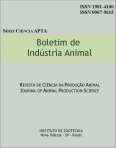Tiller classes on signalgrass pasture according to the cattle droppings position
Keywords:
Brachiaria decumbens, tiller category, tiller population density, continuous stocking, grazingAbstract
The experiment was carried out aiming to investigate the influence of natural deposition of cattle droppings on population density of several classes of tillers on the Brachiaria decumbens Stapf. cv. Basilisk pasture managed under continuous stocking. Two places on the same pasture were evaluated: one near (immediately adjacent) and one far, about 1.0 m, from the cattle droppings. Randomized block design with three repetitions was used. Tillers were classified according to the developmental stage, growth origin, defoliation rate and length. The number of vegetative tillers was higher (P<0.05) at the place that was far from the droppings (1.851 perfilhos/ m2) than at the one near them (848 perfilhos/m2). The number of reproductive tillers was higher (P<0.05) at the place near the droppings. Being near or far from the droppings showed no impact on the population density of dead tillers (584 perfilhos/m2 mean). The number of basal tiller and aerial tillers were higher (P<0.05) at the place far from the droppings, when collated to the place near the droppings. The population densities of both defoliated tillers and tillers without shoot meristem, far from the droppings, were higher (P<0.05), while the population density of nondefoliated tillers was higher (P<0.05) at the place found near the droppings. The shortest tillers were common (P<0.05) at the place far from the droppings, while the highest were frequently found (P<0.05) near the droppings. In the B. decumbens pasture under continuous stocking, deposition of droppings by cattle changes the spatial distribution of tillers categories and thus constitutes a factor causing spatial heterogeneity of vegetation.
Downloads
Downloads
Published
Issue
Section
License
Os autores não serão remunerados pela publicação de trabalhos, pois devem abrir mão de seus direitos autorais em favor deste periódico. Por outro lado, os autores ficam autorizados a publicar seus artigos, simultaneamente, em repositórios da instituição de sua origem, desde que citada a fonte da publicação original seja Boletim de Indústria Animal. A revista se reserva o direito de efetuar, nos originais, alterações de ordem normativa, ortográfica e gramatical, com vistas a manter o padrão culto da língua e a credibilidade do veículo. Respeitará, no entanto, o estilo de escrever dos autores. Alterações, correções ou sugestões de ordem conceitual serão encaminhadas aos autores, quando necessário. Nesses casos, os artigos, depois de adequados, deverão ser submetidos a nova apreciação. As opiniões emitidas pelos autores dos artigos são de sua exclusiva responsabilidade. Todo o conteúdo deste periódico, exceto onde está identificado, está licenciado sob a Licença Creative Commons Attribution (CC-BY-NC). A condição BY implica que os licenciados podem copiar, distribuir, exibir e executar a obra e fazer trabalhos derivados com base em que só se dão o autor ou licenciante os créditos na forma especificada por estes. A cláusula NC significa que os licenciados podem copiar, distribuir, exibir e executar a obra e fazer trabalhos derivados com base apenas para fins não comerciais.













